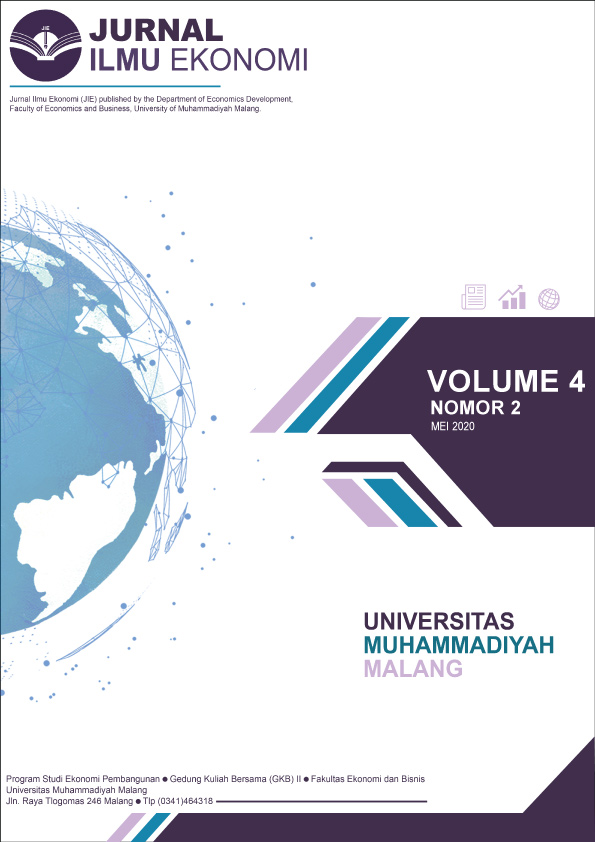ANALISIS FAKTOR YANG MEMPENGARUHI PROFITABILITAS (ROA) BANK SYARIAH DI INDONESIA TAHUN 2014-2018
DOI:
https://doi.org/10.22219/jie.v4i2.11900Keywords:
FDR, CAR, BOPOAbstract
Syariah banks is that implement syariah principle in Indonesian. Has introduced banking instutions using syaria system can be a alternative choice for muslim communities in Indonesian. In Indonesia, syariah banks have begun to develop since the issue of law No. 7 year 1992 on banking. As institutions that are important role banks need to pay attention to their performance to operate properly. Performance levels can be assessed using one of the profitability indicators that is Return On Asset (ROA). ROA is a description of the bank’s productivity in managing its funds to get the overall profit. There are indicators related to ROA analysis such as FRD, CAR, BOPO. The purpose of this research is to know the influence of FDR, CAR, BOPO on the profitability of ROA on syariah banks in Indonesian. The method used is multiple regression. Data is processed through e-views. The number of samples used is 13 syariah banks. The result showed the fDR signicantly negative effect on ROA with a coefficient value of -3.77E and a probability of 0.019, CAR has a significant positive effect on ROA with a coefficient value of 0.205 and a value of probability 0.0004, BOPO has a significant negative effect with a coefficient negative effect with a coefficient value of -0.106 and a probability of 0.000. FDR, CAR, BOPO is a simultan effect on ROADownloads
References
Abdullah, M. Faisal.2003. Manajemen Perbankan. Malang: UMM Press. Adiputra, F. (2017). Pengaruh CAR, NPF, FDR dan BOPO Terhadap Profitabilitas (ROA dan ROE) Pada Bank UmumSyariah. In Journal of Chemical Information and Modeling (Vol. 53, Issue 9). Almunawwaroh, M., & Marliana, R. (2018). Pengaruh Car,Npf Dan Fdr Terhadap Profitabilitas Bank Syariah Di Indonesia. Amwaluna: Jurnal Ekonomi Dan Keuangan Syariah, 2(1), 1–17. Amalo, F. (2010). Analisis Perkembangan Fungsi Intermediasi Perbankan Syariah Di Provinsi Jawa Timur Periode Triwulan Iii 2008 – Triwulan Iii 2009. Jurnal Ekonomi Pembangunan, 8(2), 367. https://doi.org/10.22219/jep.v8i2.3611 Ananda, M. A. (2013). Analisis Pengaruh CAR, FDR, NPF dan BOPO Terhadap ROA Bank Umum Syariah. Journal of Separation Science and Engineering, 5(1), 11–21. Edhi Satriyo Wibowo, M. S. (1955). ANALISIS PENGARUH SUKU BUNGA, INFLASI, CAR, BOPO, NPF TERHADAP PROFITABILITAS BANK SYARIAH. Polski Tygodnik Lekarski, 10(6), 191. Febrianthi, P. A. (2013). Pengaruh Car, Bopo, Npf, Dan Fdr Terhadap Roa Bank Umum Syariah Di Indonesia. Ilmiah, 1(2). Hakiim, N. (2018). Pengaruh Internal Capital Adequency Ratio (Car), Financing To Deposit Ratio (Fdr), Dan Biaya Operasional Per Pendapatan Operasional (Bopo) Dalam Peningkatan Profitabilitas Industri Bank Syariah Di Indonesia. Mega Aktiva: Jurnal Ekonomi Dan Manajemen, 7(1), 1. https://doi.org/10.32833/majem.v7i1.55 Indriana, D., & Zuhroh, I. (2012). Analisis Kualitas Pembiayaan Perbankan Syariah Tahun 2006-2010. Jurnal Ekonomi Pembangunan, 10(2), 121. https://doi.org/10.22219/jep.v10i2.3723 Muhamad. 2014. Manjemen Dana Bank Syariah: Yogyakarta: UPP STIM YKPN. Nurvarida, N. (2018). Analisis Pengaruh Bopo, Fdr Dan Car Terhadap Profitabilitas Bank Umum Syariah Periode 2012-2016. Puspitasari, D. (2009). Analisis Pengaruh CAR, NPL, PDN, NIM, BOPO, LDR dan Suku Bunga SBI Terhadap ROA (Studi Pada Bank Devisa di Indonesia Perioda 2003-2007). Universitas Diponegoro Semarang, 116. Rahmi, N., & Anggraini, R. (2013). Pengaruh CAR, BOPO, NPF, DAN CSR DISCLOSURE Terhadap Profitabilitas Perbankan Syariah. Jurnal Ilmiah Wahana Akuntansi, 8(2), 171–187. Reader, E. E., Cossu, R., Williams, I. D., Haas, W., Krausmann, F., Wiedenhofer, D., Heinz, M., Jones, P. T., Geysen, D., Tielemans, Y., Pontikes, Y., Blanpain, B., Mishra, B., Apelian, D., Krausmann, F., Gingrich, S., Eisenmenger, N., Erb, K. H., Haberl, H., … Brunner, P. H. (2012). ANALISIS NON PERFORMING FINANCING (NPF) BANK UMUM SYARIAH DI INDONESIA TAHUN 2007 – 2012. Resources, 2(10), 1–19. Rustam, B. R. 2013. Manajemen Risiko Perbankan Syariah. Jakarta: Salemba Empat. Sari, D. K. (2012). Fluktuasi Tingkat Inflasi, Suku Bunga Dan Produk Domestik Bruto Terhadap Tabungan Di Indonesia Tahun 2005-2010. Jurnal Ekonomi Pembangunan, 10(2), 102. Suwiknyo, Dwi. 2010. Analisis Laporan Keuangan Perbankan Syariah. Yogyakarta: Pustaka Pelajar. Puspitasari, D. (2009). Analisis Pengaruh CAR, NPL, PDN, NIM, BOPO, LDR dan Suku Bunga SBI Terhadap ROA (Studi Pada Bank Devisa di Indonesia Perioda 2003-2007). Universitas Diponegoro Semarang, 116. Yanti, . (2009). Pengaruh Penggunaan Modal Terhadap Tingkat Efisiensi Yang Di Capai Oleh Bank Yang Go Publik Di Bursa Efek Jakarta. Jurnal Ekonomi Pembangunan, 7(1), 33.
Downloads
Published
How to Cite
Issue
Section
License
Copyright (c) 2020 Jurnal Ilmu Ekonomi JIE

This work is licensed under a Creative Commons Attribution-ShareAlike 4.0 International License.
Authors who publish with this journal agree to the following terms:
- For all articles published in the JIE (Jurnal Ilmu Ekonomi), copyright is retained by the authors. Authors give permission to the publisher to announce the work with conditions. When the manuscript is accepted for publication, the authors agree to the automatic transfer of non-exclusive publishing rights to the publisher.
- Authors retain copyright and grant the journal right of first publication with the work simultaneously licensed under a Creative Commons Attribution-NonCommercial-ShareAlike 4.0 International License that allows others to share the work with an acknowledgement of the work's authorship and initial publication in this journal.
- Authors are able to enter into separate, additional contractual arrangements for the non-exclusive distribution of the journal's published version of the work (e.g., post it to an institutional repository or publish it in a book), with an acknowledgement of its initial publication in this journal.
- Authors are permitted and encouraged to post their work online (e.g., in institutional repositories or on their website) prior to and during the submission process, as it can lead to productive exchanges, as well as earlier and greater citation of published work (See The Effect of Open Access).
This is an open access article and licensed under a Creative Commons Attribution-NonCommercial-ShareAlike 4.0 International License








